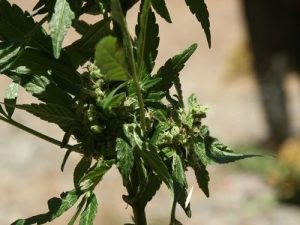San Andreas, CA — While a majority of the Calaveras County supervisors and numerous locals favor lowering the boom on commercial cannabis cultivation in their backyards a study released last week on its local economic impact conservatively estimated its 2016 production value at $252 million.
The report placed the industry’s total economic impact somewhere around $340 million, considering the ripple effects from increased spending in retail establishments and general spending in the community that occurred as a result.
Published by the University of the Pacific, Center for Business and Policy Research in Stockton, it was co-authored by Dr. Jeff Michael and Dr. Thomas Pogue, respectively the center’s executive director and associate director. The pair spent about a year researching the industry for another report in which they modeled scenarios and various industry enterprises that might be legally permitted within the Sacramento area in order to project the potential of commercial cannabis there.
The Calaveras report was commissioned by Ebbetts Pass Lumber Company owner Jason Hauer, an alumni, who saw the initial study and his own profits soar as commercial growers established their operations.
A ‘Snapshot’ Attempt
In an interview with Clarke Broadcasting Michael describes the study as a model-based estimate that attempts to capture a snapshot of 2016 cannabis cultivation industry activity in Calaveras.
The numbers are based on research he and Pogue had already done on growing operations and then adjusted, using data shared by several registered commercial growers and additional interviews and others. It excludes non-registered and personal/caregiver grows as well as sales through the county’s three legal medical marijuana dispensaries. It does not look at public costs of enforcement or expenditures of revenues.
“I think it is a reasonable estimate, not a precise tally from tax records, but building up to the best of our ability with the information that is there,” Michael explains. “We were conservative in a number of ways. We did not consider the canopy size and simply use multipliers based on best practices, for example.” Of current practices he remarks, “Locally, the growers are not getting the kind of yields and output seen from legal growers in Washington and Colorado. Most commercial grows registered under mixed light [usage] but very few are yet using that production technology, so we really dialed down our estimates, based on our interviews…but still came out with the high value output.”
Describing the economic impact of Calaveras cannabis as larger by multiples over other county agricultural industry commodities and higher than estimates of hospitality industry sales, Michael estimates that the 700-plus registered commercial marijuana grows in 2016 represented between 15 and 20 percent of the county’s economy. He also states that it was responsible for creating 2,600 year-round equivalent jobs. So, for good or for ill, he says, “[The commercial cultivation industry] is significant, and that is why people have felt the impact both economically as well as culturally in the county.”
Surging Taxable Sales A Sign Of The Times?
Among related observations Michael points to are taxable sales within the county, which last year surged ahead of neighboring counties such as Amador. “That makes sense as that it is a result of, if you have had a significant increase of economic activity. Of course, it will be different between different merchants, as the hardware and lumber outlet in Arnold saw a large increase in sales.” In an interesting aside, Michael shares it was similarly hardware and materials suppliers that helped finance his center’s Sacramento research.
Adding another anecdotal reference that could reflect an influx of activity in Calaveras last year, Michael mentions that when U-Haul Corporation published its annual list of top one-way U-Haul drop offs, Angels Camp cracked the Top 20 for small communities across the country.
As the state moves forward towards the establishment of “track and trace” structuring and commercial grows, with the passage of Prop 64, will additionally serve legal recreational users, Michael projects that there will be fewer commercial growers and operations will move away from outdoor one-harvest growing towards more efficient year-round greenhouse technologies. He further maintains that areas like Calaveras with relative proximity to urban areas like the Bay Area and Sacramento will have an ability to thrive because they can more easily truck in their legally grown yields for processing and development into other products.
Potential For A Strong Legal Industry?
Could a strong legal industry in Calaveras inhibit the currently existing illegal one? Michael qualifies his response. “If the resources for enforcement are there and the presence of the industry helps generate it,” he states. “That is the goal and the target…Prop 64 proponents want the illegal industry out.”
As for Humboldt County, a poster child for ban supporters, Michael says it is unlikely that market will become legal anytime soon. “The scale of operations is so huge already…we expect most of their crop to be sold illegally until more of the country moves towards legalizing it,” he opines. However he notes strides towards legitimization such as a state task force already busily seeking solutions to the industry’s cash and banking issues.
As commercial cannabis continues to establish itself, both as an agricultural commodity and state-regulated industry, Michael states,”Things could look a lot different moving forward…they could change quickly.”
Should Calaveras decide to sway in support commercial marijuana cultivation, which at this point is uncertain, Michael plans continuing his industry study from other angles. “I would like to look at some of the fiscal and tax revenue issues,” he states. “They are important…in thinking about enforcement resources and best possible outcomes…that provide for the county’s needs…and…a healthy industry of legitimate operators.”


